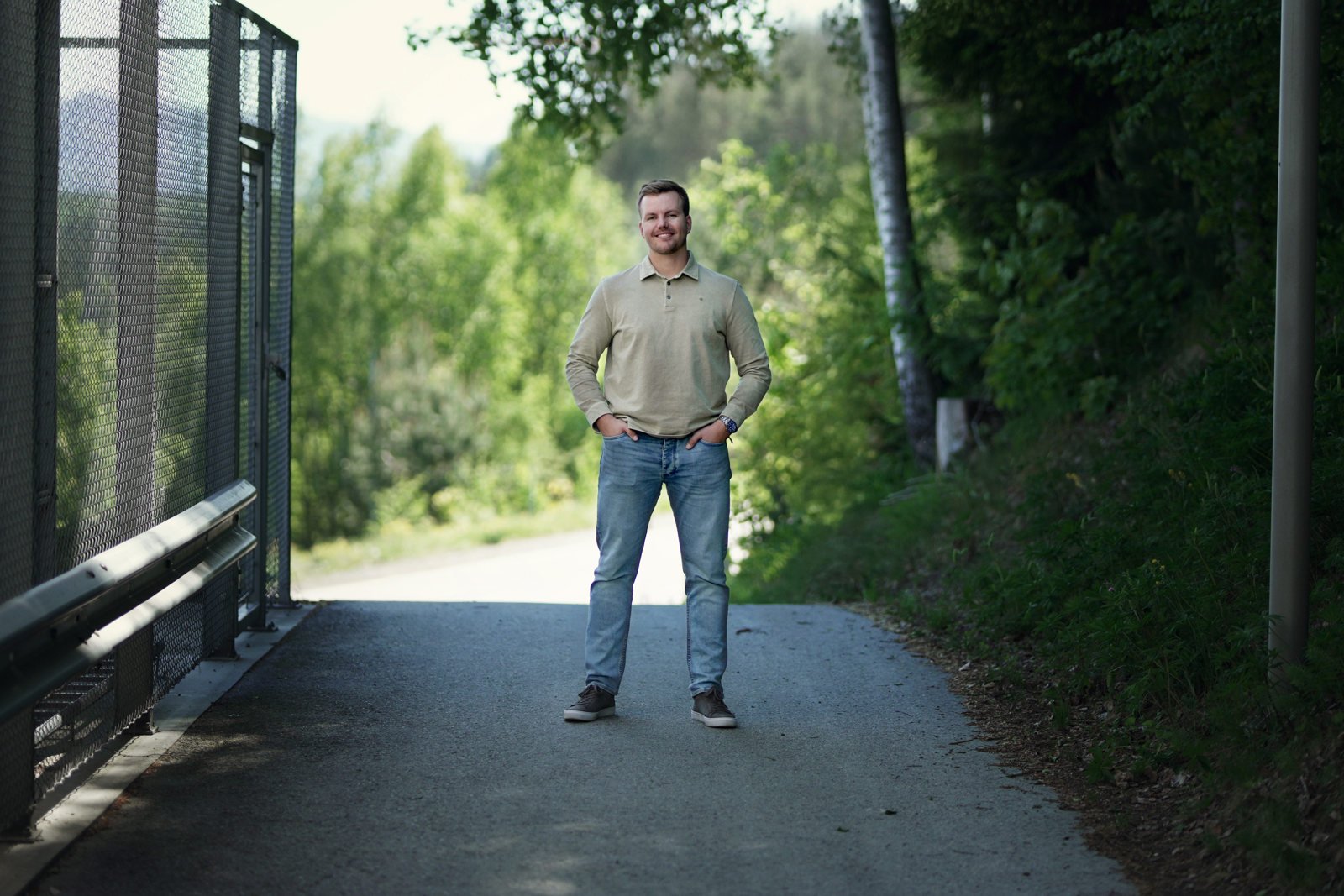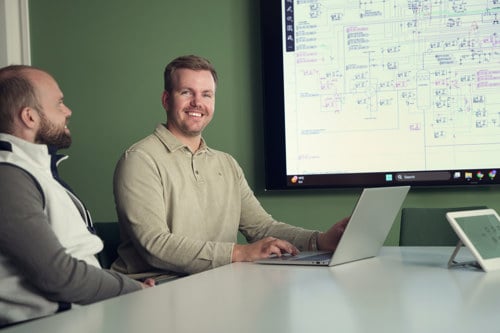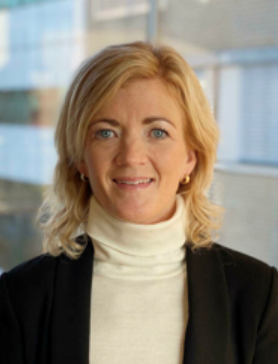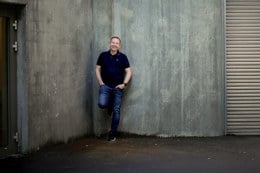
Being a lead engineer in Kongsberg Maritime
What does it take to lead some of the most complex engineering projects in the maritime industry today? For Jens-Ingeman Stad Fosseli and Sondre Momrak Larsen, the answer lies in a mix of deep technical expertise, curiosity, and the ability to lead others.
-
Text:Christine Oulie
Photo:©Andres Vargas
A look into the work of our lead engineers
We sat down with them to hear their stories, insights, and what drives them in their roles. Jens-Ingeman has spent over a decade refining K-Bridge, our integrated navigation system, while Sondre has played a key role in Johan Sverdrup, one of Norway’s largest offshore developments.
According to Elin Trillhus, Department Manager, Lead Engineers are vital to the organization’s success. They bring deep technical knowledge, lead complex projects, and act as role models. A strong lead engineer has a forward-looking mindset and works strategically to prepare us for tomorrow’s challenges,” says Elin Trillhus.
Meet Jens-Ingeman: navigating complexity

As lead engineer for Navigation Systems, Jens-Ingeman has built broad expertise across service, hardware, and systems engineering. His deep knowledge of K-Bridge enables him to lead demanding retrofit projects, upgrading navigation systems on vessels and rigs during their 10–15-year dockings.
In the early stages of a project, he supports the sales team by conducting technical surveys. These assessments help evaluate existing infrastructure and ensure that proposed solutions meet both regulatory standards and customer expectations. “Being involved early helps reduce risk and improves delivery accuracy,” he explains. From initial surveys to final sea trials, he ensures every delivery is compliant, reliable, and tailored to operational needs.
A key milestone in every project is the Factory Acceptance Test (FAT), conducted at a Kongsberg Maritime facility. It verifies that the hardware and software meet project specifications before installation. Once the system is powered up, commissioning begins - bringing hardware and software together into a working system. The final step is sea trials, where the system is tested with the class society and vessel owner. “When we power up the system, that’s when everything comes to life. Hardware, software, and signals start working in harmony.”
“What’s unique about working with K-Bridge is that we’re responsible for both the hardware and the software. That’s not something you see in many other parts of the company. Personally, I enjoy both sides. It gives me a much more complete understanding of how the system works as a whole.”
His deep familiarity with K-Bridge is what makes him a go-to expert. The system includes radar, route planning, autopilot, bridge watch, and sensor integration.

One of the most exciting parts of his work is autopilot tuning, typically done during sea trials. Engineers steer the vessel using the autopilot and adjust the four rudder parameters - rudder and counter - rudder for both port and starboard until the system achieves minimal heading deviation. “You’re calibrating the system to match the vessel’s response. When the deviation drops to zero, it’s tuned perfectly tuned. Steering during trials is a rare and rewarding part of the job,” he says.
Meet Sondre: a lead engineer’s Impact

In the world of offshore oil and gas, where safety, precision, and reliability are non-negotiable, the systems that keep everything running are only as strong as the people behind them. One of those people is Sondre Momrak Larsen, a lead engineer at Kongsberg Maritime.
Sondre is involved in the development and configuration of automation and process control systems for offshore operations, using tools such as Kongsberg Maritime’s AIM software running on proprietary hardware. AIM is used to control and monitor industrial processes on offshore installations - essentially acting as the central nervous system of the operation. “I configure and optimize the process control system,” he says. “That includes everything from compressors and pumps to valves and the flow of oil and gas.” Sondre ensures that every system is safe, efficient, and tailored to the needs of each project.
As a lead engineer, he also plays a strategic role - coordinating technical work across teams, supporting colleagues, and helping improve internal tools and workflows. “I work closely with other lead engineers to make sure our systems function as one,” he says. “And I gather feedback from the team to help improve how we work.”

Brit Skadberg, Vice President of Integration, adds: “The technical lead plays a crucial role in the project management team and in building customer relationships across all regions. When challenges arise, they are the ones who step up, ensuring collaboration and maintaining a performance culture where we celebrate successes and learn together.”
Working on one of Norway’s largest offshore projects
Among the many projects Sondre has worked on, one stands out: Johan Sverdrup. This massive offshore development is one of the largest in Norway’s history. “Johan Sverdrup includes five platforms - two of which are process platforms - and thousands of people have been involved,” Sondre explains. “It’s the biggest project I’ve worked on, and it’s been a huge learning experience.”
Kongsberg Maritime was brought in to deliver the Safety and Automation Systems (SAS) for the project, working closely with Equinor, the operator. We have been involved in all three phases of the project.
Considering that Johan Sverdrup accounts for about one-third of Norway’s oil production, the pressure is real. “You feel the responsibility in those moments,” he says. “It’s not just about getting the job done - it’s about getting it right.”
Even with careful planning, real-world systems can behave unpredictably. “On paper, everything looks perfect,” Sondre says. “But in practice, things like valve controllers can fail to respond as expected.” That’s when experience and teamwork make the difference. “We’d gather a group of engineers, sketch out ideas, and test different solutions. It’s very collaborative. And because we’ve built a strong relationship with the customer, we’re able to work closely with them to solve problems quickly and effectively.”
Curiosity and continuous growth
For Jens-Ingeman, the connection to the sea has always been there. He grew up around boats and comes from a long line of seafarers, so working in maritime felt like a natural fit. “I didn’t end up becoming a captain like some in my family, but now I get to support them - making sure they have the navigation systems they need to do their job safely and efficiently.”

He studied mechatronics, but most of what he knows today has come from being hands-on and staying curious. “When I started, I didn’t know much. But by getting involved, asking questions, and learning from experience, I’ve built up my knowledge over time.”
Sondre, who holds a master’s in Process Technology, has always been the kind of person who wants to understand how things work - whether it’s a heat pump at home or a complex offshore control system. That curiosity is what led him to Kongsberg Maritime. “What drew me in was the variety. It’s not just sitting at a desk all day. There’s travel, hands-on work, and the chance to be part of everything from shipyard testing to offshore commissioning.”
He’s also passionate about helping others grow. He’s involved in the Lead Forum, where engineers work together to improve tools, workflows, and onboarding. He helps run “Community of Practice” and “Technical Hour” sessions - spaces where engineers can share what they’ve learned and support each other. “I try to stay curious, listen to what people need, and help out where I can. It’s about building a strong team.”

At the core of both Jens-Ingeman and Sondre’s work is that same mindset: curiosity. Whether it’s tuning an autopilot system or troubleshooting a control loop offshore, they’re always asking questions, digging into the details, and looking for better ways to solve problems. And in a field where precision matters, that mindset makes all the difference.
Different Paths, same curiosity
Meet Reidar and Elisabeth, engineers at Kongsberg Maritime who each bring deep expertise in their field. Their career paths and technical focus areas are quite different, but they share one important trait: curiosity. If you're curious about what technical career paths look like in practice, take a look at their stories.
- Junior Automation and Mechatronics EngineerLocation:Kongsberg Maritime Poland Sp. z o.o, Szczecin, Polskaread more
- Service Manager P&HLocation:Kongsberg Maritime - Global Customer Support, Kongsberg Maritime Turkey - Cevizli Mah. Tugay Yolu Cad. No: 69/A Piazza Ofis Kat: 13 No:40 34846 Maltepe / Istanbul - Turkiyeread more
- Workshop TechnicianLocation:Kongsberg Maritime Netherlands, Spijkenisse, NLread more
- Team Manager, Loading & StabilityLocation:Kongsberg Maritime - Global Customer Support, Trondheimread more
- Team Manager - Field Service, KongsbergLocation:Kongsberg Maritime - Global Customer Support, Kongsbergread more
- International Service EngineerLocation:Kongsberg Maritime Poland Sp. z o.o, Szczecin, Polskaread more
- Summer Job 2026Location:Kongsberg Maritime - Propulsion & Handling, Kristinehamn, Swedenread more
- Service EngineerLocation:Kongsberg Maritime Netherlands, Spijkenisse, NLread more
- Project ProcurementLocation:Kongsberg Maritime Singapore, Singaporeread more
- Field Service Engineer Automation & Control - Netherlands (m / f / x)Location:Kongsberg Maritime Netherlands, Spijkenisse, NLread more

